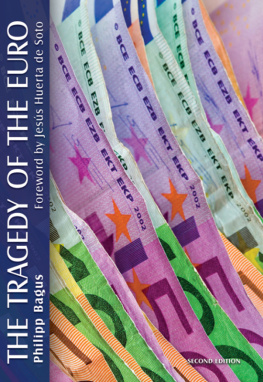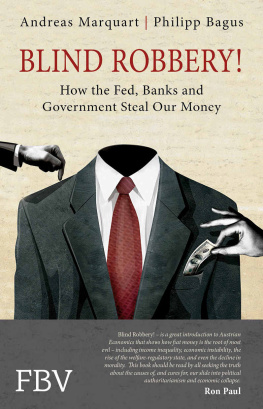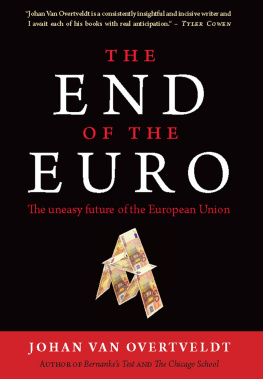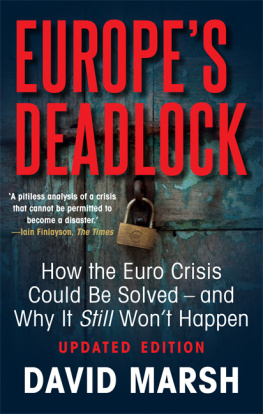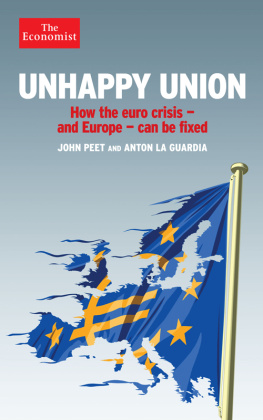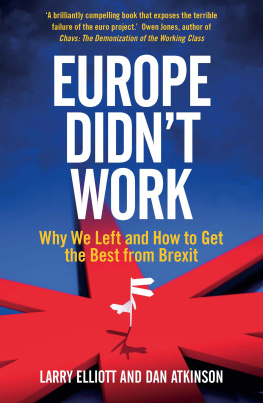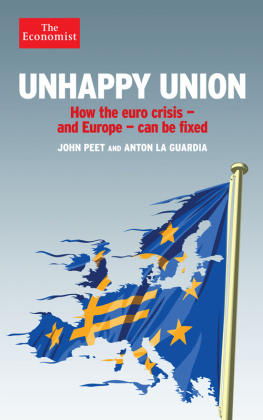The TRAGEDY
of the EURO
The TRAGEDY
of the EURO
PHILIPP BAGUS
SECOND EDITION
MISES
INSTITUTE

2010 Ludwig von Mises Institute
2011 Terra Libertas
2012 Ludwig von Mises Institute
Ludwig von Mises Institute
518 West Magnolia Avenue
Auburn, Alabama, 36832, U.S.A.
Mises.org
ISBN: 978-1-61016-249-4
To Eva
Contents
Graphs
Tables
Acknowledgments
I would like to thank Daniel Ajamian, Brecht Arnaert, Philip Booth, Brian Canny, Nikolay Gertchev, Robert Grzinger, Guido Hlsmann, and Robin Michaels for helpful comments and suggestions on an earlier draft, Arlene Oost-Zinner for careful editing, and Jess Huerta de Soto for writing the foreword. All remaining errors are my own.
Foreword
by Jess Huerta de Soto
It is a great pleasure for me to present this book by my colleague Philipp Bagus, one of my most brilliant and promising students. The book is extremely timely and shows how the interventionist setup of the European Monetary system has led to disaster.
The current sovereign debt crisis is the direct result of credit expansion by the European banking system. In the early 2000s, credit was expanded especially in the periphery of the European Monetary Union such as in Ireland, Greece, Portugal, and Spain. Interest rates were reduced substantially by credit expansion coupled with a fall both in inflationary expectations and risk premiums. The sharp fall in inflationary expectations was caused by the prestige of the newly created European Central Bank as a copy of the Bundesbank. Risk premiums were reduced artificially due to the expected support by stronger nations. The result was an artificial boom. Asset price bubbles such as a housing bubble in Spain developed. The newly created money was primarily injected in the countries of the periphery where it financed overconsumption and malinvestments, mainly in an overextended automobile and construction sector. At the same time, the credit expansion also helped to finance and expand unsustainable welfare states.
In 2007, the microeconomic effects that reverse any artificial boom financed by credit expansion and not by genuine real savings started to show up. Prices of means of production such as commodities and wages rose. Interest rates also climbed due to inflationary pressure that made central banks reduce their expansionary stands. Finally, consumer goods prices started to rise relative to the prices offered to the originary factors of productions. It became more and more obvious that many investments were not sustainable due to a lack of real savings. Many of these investments occurred in the construction sector. The financial sector came under pressure as mortgages had been securitized, ending up directly or indirectly on balance sheets of financial institutions. The pressures culminated in the collapse of the investment bank Lehman Brothers, which led to a full-fledged panic in financial markets.
Instead of letting market forces run their course, governments unfortunately intervened with the necessary adjustment process. It is this unfortunate intervention that not only prevented a faster and more thorough recovery, but also produced, as a side effect, the sovereign debt crisis of spring 2010. Governments tried to prop up the overextended sectors, increasing their spending. They paid subsidies for new car purchases to support the automobile industry and started public works to support the construction sector as well as the sector that had lent to these industries, the banking sector. Moreover, governments supported the financial sector directly by giving guarantees on their liabilities, nationalizing banks, buying their assets or partial stakes in them. At the same time, unemployment soared due to regulated labor markets. Governments revenues out of income taxes and social security plummeted. Expenditures for unemployment subsidies increased. Corporate taxes that had been inflated artificially in sectors like banking, construction, and car manufacturing during the boom were almost completely wiped out. With falling revenues and increasing expenditures governments deficits and debts soared, as a direct consequence of governments responses to the crisis caused by a boom that was not sustained by real savings.
The case of Spain is paradigmatic. The Spanish government subsidized the car industry, the construction sector, and the banking industry, which had been expanding heavily during the credit expansion of the boom. At the same time a very inflexible labor market caused official unemployment rates to rise to twenty percent. The resulting public deficit began to frighten markets and fellow EU member states, which finally pressured the government to announce some timid austerity measures in order to be able to keep borrowing.
In this regard, the single currency showed one of its advantages. Without the Euro, the Spanish government would have most certainly devalued its currency as it did in 1993, printing money to reduce its deficit. This would have implied a revolution in the price structure and an immediate impoverishment of the Spanish population as import prices would have soared. Furthermore, by devaluating, the government could have continued its spending without any structural reforms. With the Euro, the Spanish (or any other troubled government) cannot devalue or print its currency directly to pay off its debt. Now these governments had to engage in austerity measures and some structural reforms after pressure by the Commission and member states like Germany. Thus, it is possible that the second scenario for the future as mentioned by Philipp Bagus in the present book will play out. The Stability and Growth Pact might be reformed and enforced. As a consequence, the governments of the European Monetary Union would have to continue and intensify their austerity measures and structural reforms in order to comply with the Stability and Growth Pact. Pressured by conservative countries like Germany, all of the European Monetary Union would follow the path of traditional crisis policies with spending cuts.
In contrast to the EMU, the United States follows the Keynesian recipe for recessions. In the Keynesian view, during a crisis the government has to substitute a fall in aggregate demand by increasing its spending. Thus, the US engages in deficit spending and extremely expansive monetary policies to jump start the economy. Maybe one of the beneficial effects of the Euro has been to push all of the EMU toward the path of austerity. In fact, I have argued before that the single currency is a step in the right direction as it fixes exchange rates in Europe and thereby ends monetary nationalism and the chaos of flexible fiat exchange rates manipulated by governments, especially, in times of crisis.
My dear colleague Philipp Bagus has challenged me on my rather positive view on the Euro from the time when he was a student in my class, pointing correctly to the advantages of currency competition. His book, The Tragedy of the Euro, may be read as an elaborated exposition of his arguments against the Euro. While the single currency does away with monetary nationalism in Europe from a theoretical point of view, the question is: just how stable is the single currency in actuality? Bagus deals with this question from two angles, providing at the same time the two main achievements and contributions of the book: a historical analysis of the origins of the Euro and a theoretical analysis of the workings and mechanisms of the Eurosystem. Both analyses point in the same direction. In the historical analysis, Bagus deals with the origins of the Euro and the ECB. He uncovers the interests of national governments, politicians and bankers in a similar way that Rothbard does in relation to the origin of the Federal Reserve System in
Next page
